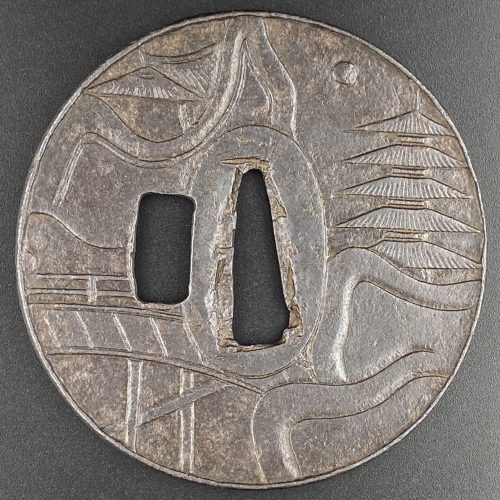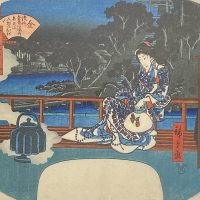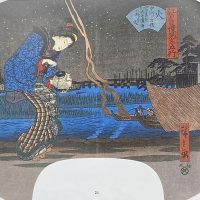-
 Iron tsuba with design of a cricket and grass inlaid in brass (suemon-zōgan) and a bridge over a stream in openwork (sukashi) on both sides. Inlay of distant part of the cricket's antenna is missing. Heianjō School. Momoyama period. Diameter: 79.5 mm, thickness at seppa-dai: 3.3 mm NBTHK # 4002100.
Iron tsuba with design of a cricket and grass inlaid in brass (suemon-zōgan) and a bridge over a stream in openwork (sukashi) on both sides. Inlay of distant part of the cricket's antenna is missing. Heianjō School. Momoyama period. Diameter: 79.5 mm, thickness at seppa-dai: 3.3 mm NBTHK # 4002100. -

The thin iron plate of round form and black colour carved in sukidashi-bori with the design of rocks, waves, bridge, mountain pavilion and 5-storey pagoda under the moon, on both sides, alluding to Todai-ji temple in Nara. Slightly rounded rectangular hitsu-ana probably pierced later. Very narrow raised rim as usual in katsushi tsuba. In a modern wooden box.
Late Muromachi period, 16th century. Dimensions: 81.1 x 79.5 x 3. mm (seppa-dai), 2.2 mm (base plate), 4.4. (rim).Reference: “Art of the Samurai” on page 232, №140: ”Kamakura tsuba with Sangatsu-do tower and bridge. Muromachi period, 16th century. 83 mm x 80 mm. Unsigned. Tokyo National Museum. The mountain pavilion and bridge carved in sunken relief on the iron tsuba – both part of Tōdai-ji, a temple in Nara – are detailed in fine kebori (line) engraving. As a result of the chiselling used to create the relief, the ground of the piece is relatively thin”. Also page 41 in Tsuba Kanshoki. Kazutaro Torogoye, 1975 [LIB-1480.2018].
This tsuba is very much similar to TSU-0384. -
 Iron tsuba of quatrefoil form with design of bamboo stems and leaves, and a plank bridge in openwork (sukashi). Hitsu-ana of irregular form. Iron with smooth chocolate patina. Copper and shakudō sekigane. This piece is illustrated in Sasano: Japanese Sword Guard Masterpieces from the Sasano Collection, 1994 on page 295 under № 254 with the following description:
Iron tsuba of quatrefoil form with design of bamboo stems and leaves, and a plank bridge in openwork (sukashi). Hitsu-ana of irregular form. Iron with smooth chocolate patina. Copper and shakudō sekigane. This piece is illustrated in Sasano: Japanese Sword Guard Masterpieces from the Sasano Collection, 1994 on page 295 under № 254 with the following description:Nishigaki. First generation Kanshiro (died in the sixth year of Genroku, 1693, at the age of 81). Sukashi design: Bamboo (take). Early Edo period, late 17th century (Kanbun / Enppo era). Height: 72.6 mm; Width: 71.5 mm; Rim thickness: .6 mm; Centre thickness: 5.1 mm. Rounded rim. The shape of this sword guard is a quatrefoil and the design is arranged in the form of a saddle flap. Two bamboo trunks with leaves comprise the design. Calm, soothing and sophisticated are the features of this artist in his later years. Such characteristics may remind one of the work of the first Hikozo.
Provenance: Sasano Masayuki collection, № 254. What is interesting, and what had been found by Bruce Kirkpatrick, is that in the earlier photograph of the same piece ['Sukashi tsuba - bushido no bi' by Sasano Masayuki, photography by Fujimoto Shihara, 1972 (in Japanese), page 245, №201] we clearly see kebori - linear carving that decorates the bamboo leaves and the planks of the bridge. The said kebori have totally disappeared between 1972 and 1994. The tsuba became absolutely flat! Now we can only speculate about the reasons for such cruel treatment of the artistically and historically important item.
Sukashi tsuba - bushido no bi. Author: Sasano Masayuki, photography: Fujimoto Shihara, 1972 (in Japanese). Page 245, №201.
-
 One of five fan prints from the series The Pride of Edo Compared to the Five Elements [Edo jiman mitate gogyo]. Artist: Utagawa Hiroshige [歌川 広重] a.k.a. Andō Hiroshige [安藤 広重] (Japanese, 1797 – 1858). Publisher: Ibaya Kyubei [伊場屋 久兵衛] (Japanese, fl. 1804 – 1851). Signed: Hiroshige ga Censor’s seal: Muramatsu Publisher's seal: Kinseido (Ibaya Kyubei) The text in the fan-shaped cartouche reads: "Water: The Square Aqueduct that Crosses by Suido Bridge Suggests the comparison of Ochanomizu to Water [Mizu: Ochanomizu josui no himasu Suidobashi areba gogyo no uchi mizu ni nazorau]". Ref: Rupert Faulkner. Hiroshige Fan Prints. Victoria and Albert Museum. Far Eastern Series. Hardcover - Harry N. Abrams, Inc. - 2001 [LIB-1344.2017] № 22, p. 51. Comment from Sebastian Izzard: This series of five prints features full-length figures of women set in landscapes around Edo compared to the five natural elements: fire, water, earth, wood, and metal. A preparatory drawing for the “Wood” image, featuring a woman crossing a bridge in the snow at the timber yards of Fukagawa, is owned by the Kanagawa Prefectural Museum of History in Yokohama. A preparatory drawing also exists for the “Earth” image, which portrays a woman seated on a bench at Nakabashi, for which no print is extant. Two examples exist of the “Fire” subject, which pictures a woman holding a lantern at night on an embankment, while in the river behind her fishermen employ fire to trap their catch. The “Water” image depicts a woman on a pleasure boat on the Ocha-no-mizu waterway. One example of the “Metal” subject is known, which was included in Izzard's Important Japanese Prints 1830–1860 March 14–20, 2020 exhibition [LIB-2398.2020], as №. 51.
One of five fan prints from the series The Pride of Edo Compared to the Five Elements [Edo jiman mitate gogyo]. Artist: Utagawa Hiroshige [歌川 広重] a.k.a. Andō Hiroshige [安藤 広重] (Japanese, 1797 – 1858). Publisher: Ibaya Kyubei [伊場屋 久兵衛] (Japanese, fl. 1804 – 1851). Signed: Hiroshige ga Censor’s seal: Muramatsu Publisher's seal: Kinseido (Ibaya Kyubei) The text in the fan-shaped cartouche reads: "Water: The Square Aqueduct that Crosses by Suido Bridge Suggests the comparison of Ochanomizu to Water [Mizu: Ochanomizu josui no himasu Suidobashi areba gogyo no uchi mizu ni nazorau]". Ref: Rupert Faulkner. Hiroshige Fan Prints. Victoria and Albert Museum. Far Eastern Series. Hardcover - Harry N. Abrams, Inc. - 2001 [LIB-1344.2017] № 22, p. 51. Comment from Sebastian Izzard: This series of five prints features full-length figures of women set in landscapes around Edo compared to the five natural elements: fire, water, earth, wood, and metal. A preparatory drawing for the “Wood” image, featuring a woman crossing a bridge in the snow at the timber yards of Fukagawa, is owned by the Kanagawa Prefectural Museum of History in Yokohama. A preparatory drawing also exists for the “Earth” image, which portrays a woman seated on a bench at Nakabashi, for which no print is extant. Two examples exist of the “Fire” subject, which pictures a woman holding a lantern at night on an embankment, while in the river behind her fishermen employ fire to trap their catch. The “Water” image depicts a woman on a pleasure boat on the Ocha-no-mizu waterway. One example of the “Metal” subject is known, which was included in Izzard's Important Japanese Prints 1830–1860 March 14–20, 2020 exhibition [LIB-2398.2020], as №. 51.
Metal. Izzard, 2020.

Fire. Faulkner, 2001.


